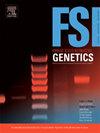推进法医体液鉴定:RT-LAMP+CRISPR-Cas12a与已建立的基于mrna的方法的比较分析
IF 3.1
2区 医学
Q2 GENETICS & HEREDITY
引用次数: 0
摘要
在法医学中,对体液证据的分析确定了样本的细胞来源,有助于重建潜在的犯罪。基于信使核糖核酸(mRNA)的验证性测试解决了当前常规方法的局限性,提供更高的特异性和敏感性,最小的样品消耗,以及更广泛的体液检测范围。然而,它们需要昂贵的仪器,较长的反应时间,并且缺乏可移植性。逆转录环介导的等温扩增(RT-LAMP)与CRISPR相关蛋白12a (Cas12a)的聚集规则间隔短回文重复序列(CRISPR)偶联具有克服这些挑战的潜力。正如在病毒诊断领域所观察到的那样,这种方法减少了检测时间和成本,同时可能提供同等的灵敏度和特异性。视觉检测能力使我们能够开发出适合在犯罪现场进行检测的快速、便携式筛选测试。在性侵犯调查的背景下,RT-LAMP+CRISPR-Cas12a可能会提高效率和检出率。本研究将这种新方法与其他两种基于mrna的方法,终点逆转录聚合酶链反应(RT-PCR)多重检测CellTyper 2和实时逆转录定量PCR (RT-qPCR)多重检测进行了比较。测试的敏感性和特异性评估了单一来源和混合体液样本,包括直肠粘膜,一种在法医文献中很少探讨的液体。RT-qPCR检测在混合样品中显示出最高的灵敏度、特异性和精度。此外,与CellTyper 2相比,RT-qPCR提供了更大的线性动态范围,更快的处理时间和更简单的方法,只是受到其昂贵性质的限制。值得注意的是,直肠粘膜样品在所有方法中均表现出细胞2型标记物的非特异性表达和CYP2B7P(阴道液)的表达。这强调需要一个专门的直肠粘膜标记物。RT-LAMP+CRISPR-Cas12a表现出高特异性,CYP2B7P在两种液体类型中脱靶表达。然而,该方法对除MMP3(经血)外的大多数标记物缺乏敏感性和精确性,检测率低至1:10 000,特异性为100 %。RT-LAMP+CRISPR需要进一步发展,但其快速、廉价和高特异性的特性表明,它有潜力作为一种验证性测试,可以减少现有方法的局限性。本文章由计算机程序翻译,如有差异,请以英文原文为准。
Advancing forensic body fluid identification: A comparative analysis of RT-LAMP+CRISPR-Cas12a and established mRNA-based methods
In forensic science, the analysis of body fluid evidence determines the cellular origin of a sample, aiding in the reconstruction of a potential crime. Messenger ribonucleic acid (mRNA) based confirmatory tests address limitations of current conventional methods, providing increased specificity and sensitivity, minimal sample consumption, and the detection of a broader range of body fluids. However, they require expensive instrumentation, longer reaction times, and lack portability. Reverse-transcription loop-mediated isothermal amplification (RT-LAMP) coupled with clustered regular interspaced short palindromic repeats (CRISPR) with CRISPR-associated protein 12a (Cas12a) has the potential to overcome these challenges. This approach offers reduced testing time and cost, while potentially providing equivalent sensitivity and specificity, as observed in the field of viral diagnostics. Visual detection capabilities enable the development of rapid, portable screening tests suitable for testing at the crime scene. In the context of a sexual assault investigation, RT-LAMP+CRISPR-Cas12a could potentially increase the efficiency and detection rate. This study compares this novel method to two other mRNA-based methods, endpoint reverse transcription polymerase chain reaction (RT-PCR) multiplex assay CellTyper 2, and a real-time reverse transcription quantitative PCR (RT-qPCR) multiplex assay. The tests’ sensitivity and specificity were evaluated on single-source and mixed body fluid samples, including rectal mucosa, a fluid which is minimally explored in forensic literature. The RT-qPCR assay demonstrated the highest sensitivity, specificity, and precision in mixed samples. In addition, RT-qPCR offers a greater linear dynamic range, faster processing time and easier methodology compared to CellTyper 2, only limited by its expensive nature. Notably, rectal mucosa samples exhibited non-specific marker expression of CellTyper 2 markers and expression of CYP2B7P (vaginal fluid) for all methods. This emphasises the need for a dedicated rectal mucosa marker. RT-LAMP+CRISPR-Cas12a exhibited a high specificity, displaying off-target expression of CYP2B7P in two fluid types. However, the method lacked sensitivity and precision for most markers except MMP3 (menstrual blood), demonstrating detection down to 1:10,000 with 100 % specificity. RT-LAMP+CRISPR requires further development, but its quick, inexpensive nature and high specificity suggest it has potential as a confirmatory test that could reduce the limitations of existing methods.
求助全文
通过发布文献求助,成功后即可免费获取论文全文。
去求助
来源期刊
CiteScore
7.50
自引率
32.30%
发文量
132
审稿时长
11.3 weeks
期刊介绍:
Forensic Science International: Genetics is the premier journal in the field of Forensic Genetics. This branch of Forensic Science can be defined as the application of genetics to human and non-human material (in the sense of a science with the purpose of studying inherited characteristics for the analysis of inter- and intra-specific variations in populations) for the resolution of legal conflicts.
The scope of the journal includes:
Forensic applications of human polymorphism.
Testing of paternity and other family relationships, immigration cases, typing of biological stains and tissues from criminal casework, identification of human remains by DNA testing methodologies.
Description of human polymorphisms of forensic interest, with special interest in DNA polymorphisms.
Autosomal DNA polymorphisms, mini- and microsatellites (or short tandem repeats, STRs), single nucleotide polymorphisms (SNPs), X and Y chromosome polymorphisms, mtDNA polymorphisms, and any other type of DNA variation with potential forensic applications.
Non-human DNA polymorphisms for crime scene investigation.
Population genetics of human polymorphisms of forensic interest.
Population data, especially from DNA polymorphisms of interest for the solution of forensic problems.
DNA typing methodologies and strategies.
Biostatistical methods in forensic genetics.
Evaluation of DNA evidence in forensic problems (such as paternity or immigration cases, criminal casework, identification), classical and new statistical approaches.
Standards in forensic genetics.
Recommendations of regulatory bodies concerning methods, markers, interpretation or strategies or proposals for procedural or technical standards.
Quality control.
Quality control and quality assurance strategies, proficiency testing for DNA typing methodologies.
Criminal DNA databases.
Technical, legal and statistical issues.
General ethical and legal issues related to forensic genetics.

 求助内容:
求助内容: 应助结果提醒方式:
应助结果提醒方式:


